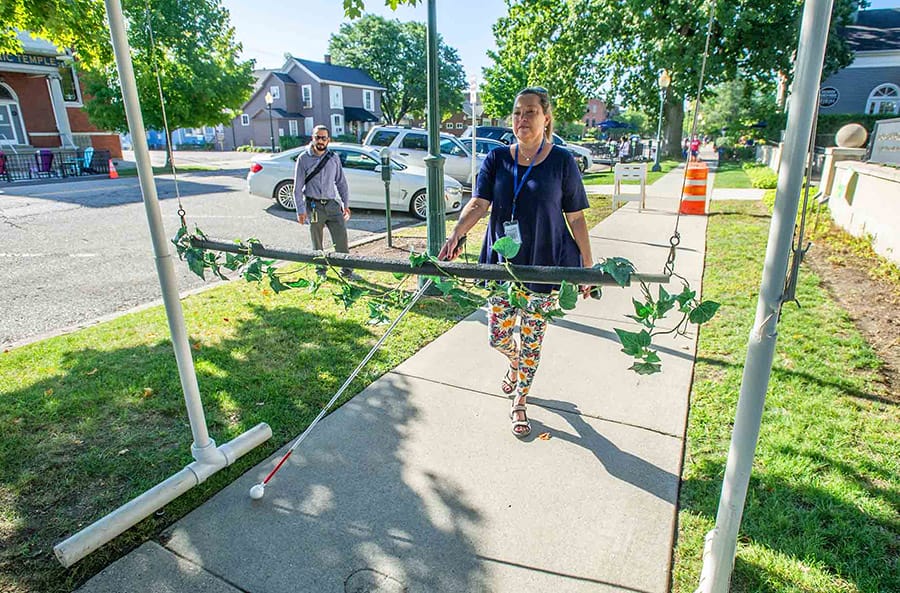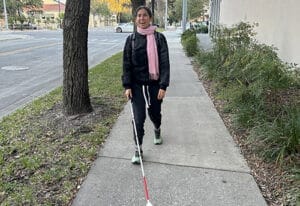By Client Justin Whittington
When writing my articles, I try to educate both the visually impaired and the sighted community. In this article, I will be going through my visit to the Leader Dog campus to answer any questions one might have and what to expect when going through [orientation and mobility] training while also illustrating the impact it has on those of us with a disability. Through Lions clubs and generous donations, Leader Dog is able to offer not only O&M training but also guide dog training and the dogs at no cost to the consumer.
For those who don’t know what O&M training is, I will gladly explain.
O&M stands for orientation and mobility training. It teaches a person with visual impairments how to use a cane to safely navigate. [The instructors] teach you how to build a mental map of your surroundings, plan routes for travel, use your cane and body to get feedback to figure out what’s around you and many other things.
O&M training is essential for any blind or visually impaired person to have any kind of independent mobility. It is also the first step in getting a guide dog. This is not only for your safety and the dog’s, but it also helps equip you with the tools you need and skills so you don’t unintentionally undo the dog’s training and shorten its career as a guide dog.
Before I go any further, I will say this post will probably answer more questions for someone who is going to attend training, but I hope someone who doesn’t have a visual impairment can see the huge impact it has on people’s lives and raise awareness so I can help encourage people to donate.
As I said earlier, all [the training] is done free of charge. The experience I had was being flown in (if someone is closer to campus, the travel will be a little different, but I did not go other routes so I can’t speak for them). The only thing i was responsible for was getting a ride to the airport. Leader Dog took care of everything else. That means they booked the flight, paid for the airline tickets and even had someone pick me up from the airport in Detroit and drive me to the campus. This is an awesome thing for anyone but is truly a blessing as many if not most people with visual impairments are on a fixed income. If they had to pay for this out of their own pocket, it would never happen for them. Again, this can be done through donations from Lions clubs and others who donate to Leader Dog.
This was not only my first time on an airplane as a blind person but my first time, period. Everyone I talked to from Leader Dog leading up to leaving for my flight did everything they could to ensure I wouldn’t have any issues. They put my worries at ease and promised I wouldn’t get lost at Detroit’s airport. They gave me the number of the gentleman who was a volunteer who would be picking me up, along with several others flying in. This gentleman was super nice. I wish I knew his last name so I could give him a proper shout-out; however, Doug, you are awesome and I appreciate you.
Once all six of us arrived, they loaded us up in a van and surprised us with a sack lunch. This wasn’t no sad sandwich. Oh no. I do have to say this was an amazing sandwich! Oh man, those people working in [the Leader Dog] cafeteria… more on them later, but let’s just say calling this a sack lunch would be akin to calling the World Series, Super Bowl or the World Cup minor sporting events.
After arriving to the Leader Dog campus, [team members] helped guide us in the building and gave us our badges and a short rundown and then showed us to our rooms.
Side note here: those attending O&M training will stay for a week while those receiving a dog will typically stay for three weeks.
The rooms are very nice. Before I lost my vision, I worked construction and helped build two hotels that were connected to a casino near where I live, and to be honest the rooms at Leader Dog was just as nice if not nicer. The rooms are huge, the beds are comfy and you even have a door leading outside. This door also serves those who are getting dogs easier access to go and “park” their dogs… don’t forget the bags… each room has its own Amazon Echo Dot and Fire TV set up for the visually impaired, a desk, a closet, a phone and a chair by the bed you can lounge comfortably in.
Warning: make sure you check the alarm volume on the Echo Dot before you rely on it to wake you up… more on that later as well.
Last but not least, you have your own bathroom. I know every hotel room has this, but I’m the type of person that if it doesn’t explicitly say something, I wonder.
In the dormitory, there is a common area with a piano, a couple of guitars and accordion. This is a general gathering place for people in attendance to socialize and is generally where everyone waits on the cafeteria to open. For the musician readers, yes, you can play the instruments. They have been donated for clients to use. There is also a room with vending machines, both food and drink, and a tea/coffee station. The station is free.
There is also a media room, which has a computer, books both in audio and Braille format and other adaptive technology that can be used.
There is also a park (for the lack of a better term) that you can spend time in. This area also has a course that you can walk around.
And last but certainly not least, the cafeteria… oh, the cafeteria. First off, they find out before you even go if you have any food restrictions or allergies and prepare your meals accordingly. When you sit down for your first meal when you get to the campus, they will sit you down in your assigned place (cool note is they have your seat number both in tactile raised numerals and in Braille for those who can read it). They will ask you what your drink preferences are for each meal. You have several different choices of hot teas, coffee, ice tea and water. They will have this ready for you at each meal unless you call ahead and ask them for something different. They cook you three lovely meals every day and you can ask for some modifications or reruns if you don’t want to eat what they are having that meal. I will say they go full spread on the meals, with dessert. You can also tell them you’re going to skip a meal. This was not an option for me since the table I was sitting at had a group of lovely ladies that felt more like surrogate mothers and grandmothers, which I have to say was awesome.
You remember me saying to check the alarm volume on your Echo? Well, mine was set very low. After coming back from afternoon training one day, I’d set an alarm because I was pretty sure I would fall asleep listening to my book and didn’t want to miss supper. Fast forward to me not hearing my alarm, the aforementioned ladies getting worried about me not being at supper, them hounding the staff to find me and make sure I wasn’t lost, me hearing the phone in my room going off (not knowing what on God’s green earth that sound was), wondering where in the world I was at because I was certainly not in my room back home and subsequently falling off the bed… well, I finally made it.
As funny as all that was, it made me feel good that everyone was looking out for me. In a very short amount of time, we all fell into a family dynamic and just clicked with each other. This brings me to one of the most impactful points of [Leader Dog], and that is the feeling of being normal. I know that no one is really normal but for the first time since my vision loss started, I didn’t feel apart or different from those around me. For the first time, I was around other blind people. More importantly I was around others who could relate to me and understood what I went through on a daily basis. To be honest, there was a sense of connection with people that I’ve never experienced before. One blessing I’ve found since going blind is the ability to listen—I mean really listen. There was no snap judgement on people’s appearance, disposition or anything else. We truly just listened to each other. It takes a long time for me to truly open up to anyone, but those going through training and even the staff made me feel I could open up instantly.
That brings me to the next point in this article: the staff. These are some of the best people you will ever meet. I can’t even begin to give them enough praise! One of the most welcoming things about Leader Dog and its staff is they make a point to speak to you, learn your name and announce themselves so you know who is talking. This is everyone from the people working in the cafeteria, to the trainers, to the R.A.s. There is always a R.A. on duty for assisting you with whatever you may need. They are even there if you just want to venture down to their desk and chat. They also have volunteers who come by the campus and shop for clients if they need it (with the exception of tobacco and alcohol. Those you have to get yourself).
Before I move on to the training aspect, I will also note they have a gym and laundry room that you are free to use. To be honest, I’m sure I’ve missed something on this front that is obvious, but I’ve tried to cover everything I can remember.
Now on to the training. I know you may be wondering why this is the last part of this article. The reason is simply because all of the above things are what had me a little apprehensive about going so far away from home. As I mentioned earlier, I went [to Leader Dog] for O&M training. I met with my instructor on Monday morning. After we visited for a few and developed a plan of action and what I wanted to get out of training, she set me up with a cane for my height (yes, there are different sizes and they matter by how tall you are), gave me a basic rundown of how I should use it and experimented with different tips. I’m a marshmallow* man if anyone was wondering. We practiced inside the dorms and she helped me build a map of the place so I could wander around on my own. We also covered how to utilize a sighted guide properly, going through doorways and how to teach people in my life back home to be a proper sighted guide. After we finished that up, I got a bit of a break before lunch and was shown where to meet her again for afternoon training.
I will pause here to let you know you get breaks in between sessions. You may not think you would need them after only a few hours, but you do. You get a lot of info all at once and though it may not be physically tiring, it is mentally tiring and you need the break to process.
I won’t give a blow by blow for each session and day but will go over what all I learned to shorten this article so it doesn’t become a book… you’re welcome.
Basically, each session builds off the previous ones. You start out inside, then move to the course outside. Then you go to the Leader Dog building downtown and then learn to plan a route walking down the street. You basically start off on a block route and gradually build the distance as you get comfortable. You will learn to listen to your surroundings, get tactile feedback from your cane and feel what’s beneath your feet. In the same downtown area, you will also learn to cross streets and do course corrections should you venture off or get lost. After that you will go to a mall and learn to apply the skills you learned to navigate in a much busier place, which will hone your senses to help you navigate better. Now you’re using sound, feel and smell. Depending upon what your goals are, you may do more or less training or even do different environments. A lady who was in the same class as myself also lived in the country so they took us to what they called “rural” training. I will say at least for myself that even though the rural area was much different than mine back home, I was still able to transfer those skills when I got home. As soon as I sat my bags down, I went for a walk down my little country road.
The way it worked for me is after my morning session, I had about an hour on average to rest before lunch and a few minutes after lunch before my afternoon session. There were many times I thought the session was short and wanted to go longer, but after sitting down and actually processing the lesson, I realized I needed that break.
As long as this article is, I’ve left out many things, but I think I hit most of the highlights. I can’t give Leader Dog enough praise. Even after I returned home, they call and check up on me to see where I’m at with my O&M skills and if there is anything I need help with, and they give me recommendations. Speaking for those who receive dogs, if you have problems you don’t feel you can manage, they will send an instructor out to you. If there are other clients relatively close by, they will stop in and check up with them too.
Thank you for reading and spending a little time with me.
Find out more about our Orientation & Mobility Training program.
*White canes have detachable tips that can be swapped out according to user preference or different terrain. A marshmallow tip is cylindrical and made for the “constant contact” method of using a cane, meaning that the user sweeps the cane from side to side without picking it up from the ground.




